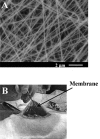Prevention of postsurgery-induced abdominal adhesions by electrospun bioabsorbable nanofibrous poly(lactide-co-glycolide)-based membranes
- PMID: 15492575
- PMCID: PMC1356499
- DOI: 10.1097/01.sla.0000143302.48223.7e
Prevention of postsurgery-induced abdominal adhesions by electrospun bioabsorbable nanofibrous poly(lactide-co-glycolide)-based membranes
Abstract
Objectives: The objective of this study was to evaluate the efficacy of nonwoven bioabsorbable nanofibrous membranes of poly(lactideco-glycolide) for prevention of postsurgery-induced abdominal adhesions.
Summary background data: Recent reports indicated that current materials used for adhesion prevention have only limited success. Studies on other bioabsorbable materials using a new fabrication technique demonstrated the promising potential of generating an improved and inexpensive product that is suitable for a variety of surgical applications.
Methods: All rats underwent a midline celiotomy. The cecum was identified and scored using an abrasive pad until serosal bleeding was noted on the anterior surface. A 1 x 1 cm of abdominal wall muscle was excised directly over the cecal wound. The celiotomy was then closed in 2 layers immediately (control) after a barrier was laid in between the cecum and the abdominal wall. All rats underwent a second celiotomy after 28 days to evaluate the extent of abdominal adhesions qualitatively and quantitatively.
Results: Cecal adhesions were reduced from 78% in the control group to 50% in the group using biodegradable poly(lactide-co-glycolide) (PLGA) nonwoven nanofibrous membranes (n = 10, P = 0.2) and to 22% in the group using membranes containing PLGA and poly(ethylene glycol)/poly(D,L-lactide) (PEG-PLA) blends (n = 9, P = 0.03). Electrospinning method also enabled us to load an antibiotic drug Cefoxitin sodium (Mefoxin; Merck Inc., West Point, PA) with high efficacy. The electrospun PLGA/PEG-PLA membranes impregnated with 5 wt% cefoxitin sodium, which amounts to approximately 10% of the systemic daily dose typically taken after surgery in humans, completely prevented cecal adhesions (0%) in rats.
Conclusions: Electrospun nonwoven bioabsorbable nanofibrous membranes of poly(lactide-co-glycolide) were effective to reduce adhesions at the site of injury using an objective rat model. The membrane acted as a physical barrier but with drug-delivery capability. The combined advantages of composition adjustment, drug-loading capability, and easy placement handling (relatively hydrophobic) make these membranes potentially successful candidates for further clinical evaluations.
Figures

References
-
- Menzies D. Peritoneal adhesions: incidence, cause and prevention. Surg Annu. 1992;24:27–45. - PubMed
-
- di Zerega GS. Contemporary adhesion prevention. Fertil Steril. 1994;61:219–235. - PubMed
-
- Holtz G. Prevention and management of peritoneal adhesions. Fertil Steril. 1984;41:497–507. - PubMed
-
- Ellis H. The causes and prevention of intestinal adhesions. Br J Surg. 1982;69:241–243. - PubMed
Publication types
MeSH terms
Substances
Grants and funding
LinkOut - more resources
Full Text Sources
Other Literature Sources
Medical

